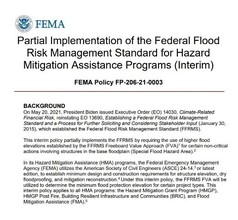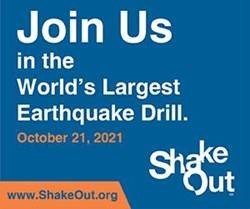| Today, Sept. 30, 2021, the fiscal year 2021 application period opened for the Building Resilient Infrastructure and Communities (BRIC) and Flood Mitigation Assistance (FMA) grant programs. There is $1 billion available for the BRIC program, and $160 million available for the FMA program. The application period closes on Jan. 28, 2022. FEMA announced the Notices of Funding Opportunities for the two grant programs in early August to combat climate change and protect underserved communities against disaster hazards. FEMA has also released guidance for states, local communities, tribal and territorial governments to streamline the application process for hospital generators, acquisitions and elevations projects. FEMA understands that the effort necessary to demonstrate cost-effectiveness for projects can increase the burden on subapplicants, particularly those with limited access to resources. Streamlining the process shows FEMA's commitment to deliver its hazard mitigation programs with equity and supports building capacity and capability in underserved and at-risk communities. The guidance establishes pre-calculated benefit values to reduce the time and resources needed to complete and review cost-effectiveness for hospital generators, acquisitions, and elevation projects. In addition, it aims to increase the availability of mitigation opportunities to help communities increase resilience against future disasters. The Benefit Cost Analysis Helpline hours are 9 a.m. - 5 p.m. Eastern Time, Monday through Friday. Email questions to bchelpline@fema.dhs.gov or call toll free at 855-540-6744. For more information about guidance on acquisitions, elevation and hospital generator projects, view the memorandums, Pre-Calculated Benefits for Certain Hospital Generators to Demonstrate Cost-Effectiveness and Cost-Effectiveness Determinations for Acquisitions and Elevations in Special Flood Hazard Areas Using Pre-Calculated Benefits, on FEMA's website. Timeline Shifts to November for FY 2020 Award Delivery FEMA anticipates starting to make awards for the fiscal year 2020 Building Resilient Infrastructure and Communities (BRIC) and Flood Mitigation Assistance (FMA) grant programs in late November 2021. While FEMA initially anticipated making awards in the FEMA GO system beginning in September 2021, additional system updates are required. Learn more about the $700 million in mitigation funding that was made available for Fiscal Year 2020 through the BRIC and FMA grant programs. Building Resilient Infrastructure and Communities Competitive Project Selections The Building Resilient Infrastructure and Communities (BRIC) program supports states, local communities, tribes, and territories as they undertake hazard mitigation projects, reducing the risks they face from disasters and natural hazards. For the fiscal year 2020 application cycle, through the National Competition, FEMA's BRIC program selected 22 large competitive projects based on the highest composite score until the funding amount available, $500 million, had been reached. The selected projects total over $377 million. The 22 selected projects fall into seven categories of primary activity type: Elevation, Flood Control, Floodproofing, Relocation, Saferoom/Shelter, Utility and Infrastructure Protection, and Wildfire Management. Learn more about these projects. And visit FEMA's website to view the full summary of state, territory and tribal set-aside as well as the status of subapplications.  FEMA's Hazard Mitigation Assistance Division will host a webinar entitled Federal Agency Roundtable and Partnerships from 2 to 3:30 p.m. Eastern Time on Oct. 13. During this webinar, Ryan Janda, Hazard Mitigation Assistance Non-Disaster Grants Implementation Branch Chief, will lead a federal panel discussion on the importance of partnerships for FEMA's grant programs. The other presenters will include, Virginia Castro, Technical Energy Project Specialist , U.S. Department of Energy; Abby Hall, Senior Advisor on Local and Regional Planning, U.S. Environmental Protection Agency; Josh Human, BRIC Partnership Coordinator, FEMA; Tommy Jones, Deployment Specialist, U.S. Department of Energy Office of Indian Energy; Robin Keegan, Deputy Assistant Secretary for Economic Development, U.S. Department of Housing & Urban Development; and Andy Porth, Office of the Assistant Secretary of Defense (Sustainment). This is the final webinar of the 2021 Building Resilient Infrastructure and Communities and Flood Mitigation Assistance Webinar Series. This series brings FEMA subject-matter experts and partners together to provide technical information, best practices, tools and resources for prospective HMA grant programs' applicants and many other stakeholders. As they become available, webinar recordings are being published online. |  A new interim FEMA policy requires certain structures in Special Flood Hazard Areas to conform to higher flood elevation standards if they use Hazard Mitigation Assistance (HMA) grant funds. FEMA published the Partial Implementation of the Federal Flood Risk Management Standard for Hazard Mitigation Assistance Programs (Interim) (FEMA Policy FP-206-21-0003) to better align with Executive Order 14030 Climate-Related Financial Risk to strengthen the state of resilience nationwide. This follows the announcement of the new standard in the Fiscal Year 2021 Notices of Funding Opportunities for the Building Resilient Infrastructure and Communities (BRIC) and Flood Mitigation Assistance (FMA) programs. The interim policy became effective on Aug. 27, 2021. In addition to BRIC and FMA, it also applies to the Hazard Mitigation Grant Program (HMGP) for any major disaster declared on or after Aug. 27, and assistance authorized for all 59 COVID-19 disaster declarations. Additionally, it applies to HMGP Post Fire for any Fire Mitigation Assistance Grant (FMAG) declarations issued on or after Aug. 27. The interim policy partially implements the Federal Flood Risk Management Standard (FFRMS) by requiring higher flood elevations established by the Freeboard Value Approach for certain actions such as elevation, dry floodproofing, and mitigation reconstruction in the Special Flood Hazard Area. The Freeboard Value Approach is the Base Flood Elevation plus two feet. Under the interim policy, FEMA does not require the partial implementation of the FFRMS Freeboard Value Approach if using it would cause the project to be unable to meet applicable program cost-effectiveness requirements. FEMA anticipates this approach will ensure communities affected by flood disasters are less vulnerable to the loss of life and property and reduce the effects of a changing environment. To learn more about the interim policy, please visit FEMA.gov. |  On Aug. 16, 2021, FEMA announced the full application launch of the National Risk Index, an online resource that provides a holistic view of community risk. It provides baseline relative risk scores and ratings for 18 natural hazards in addition to community resilience, social vulnerability and expected annual loss. The tool was originally released in November 2020 at a limited capacity. Now, fully available for use by state, local, tribal and territorial partners, the National Risk Index includes the ability to generate more customized analyses and reports, including community risk profiles and risk comparison reports for any county or Census tract. Users can now share reports via unique links, save them as printable PDFs, or extract the underlying data in spatial or tabular formats. The index based ratings on data from the best available resources from 2014 through 2019. Routine updates are expected to keep ratings current. The National Risk Index is free and easy to use by anyone interested in planning for mitigation or learning about their community's natural hazard risks. Visit FEMA's National Risk Index webpage for more information. |  Are you prepared? With over 328 million people living and working in the United States, a major earthquake could cause unprecedented devastation. What you do to prepare now will determine how well you will survive and recover from the next big earthquake. Plan to participate on Oct. 21 at 10:21 a.m. local time for the International ShakeOut Day and Drop, Cover, and Hold On. As with any year, you can ShakeOut when and where you want, whether that is at home, work, school or perhaps through a video conference. Your ShakeOut activity may look different this year, but there has always been flexibility in how and when you would like to hold your drill. We encourage you, your family and co-workers to register and participate in this year's drill. The International ShakeOut Day, every third Thursday of October, is a day of individual and community events. ShakeOut features the largest earthquake drill ever organized to inspire others to get ready for big earthquakes and to prevent disasters from becoming catastrophes. While some ShakeOut drills and other activities may happen as always, there are some new considerations: - Where will you be for your drill? Together, at work, school, or home? Consider
videoconferencing! - How will you incorporate COVID-19 health and safety guidelines into your activity?
- Is it better to have everyone participate all at once, or perhaps in staggered (or even
repeated) dates and times? Registered participants will receive information on how to plan their drill and involve others. When your drill begins, remember to Drop, Cover, and Hold On! Set a stopwatch and commit to a full one-minute to practice something that can save your life. For more information, visit ShakeOut.org. | |

Comments
Post a Comment